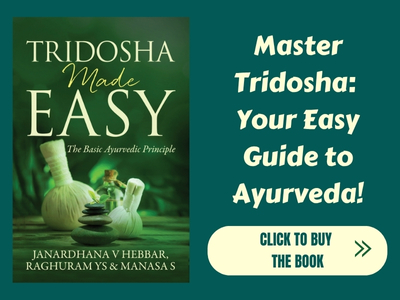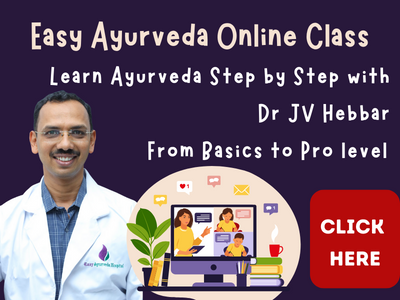The 7th chapter of Chikitsasthana of Sushruta Samhita is named as Asmari Cikitsitam Adhyaya. This chapter deals with Treatment of Urinary calculi.
अथातोऽश्मरीचिकित्सितंव्याख्यास्यामः।।१।।
यथोवाचभगवान्धन्वन्तरिः।।२।।
We will now expound Asmarī Cikitsita – treatment of urinary calculi; as revealed by the venerable Dhanvantari.
Cikitsāvidha – modes of treatment
अश्मरीदारुणोव्याधिरन्तकप्रतिमोमतः।।
औषधैस्तरुणःसाध्यःप्रवृद्धश्छेदमर्हति।।३।।
तस्यपूर्वेषुरूपेषुस्नेहादिक्रमइष्यते।।
तेनास्यापचयंयान्तिव्याधेर्मूलान्यशेषतः।।४।।
Asmarī is a dreadful disease. The dreadful nature of the disease has been compared to ‘añtaka’ – the god of death. If the disease is of recent origin, it should be treated with medicines. When the size of asmari has increased and is larger, chedana should be done i.e. it needs to be cut off with the help of surgical procedure.
Therapies like oleation are desirable in the premonitory stage of the disease. By these, not only the disease gets cured but the root of the disease too will be destroyed.
Pāşāṇabhedādi Ghrta
पाषाणभेदोवसुकोवशिराश्मन्तकौतथा।।
शतावरीश्वदंष्ट्राचबृहतीकण्टकारिका।।५।।
कपोतवङ्काऽऽर्तगलःकच्चकोशीरकुब्जकाः।।
वृक्षादनीभल्लुकश्चवरुणःशाकजंफलम्।।६।।
यवाःकुलत्थाःकोलानिकतकस्यफलानिच।।
ऊषकादिप्रतीवापमेषांक्वाथैघृतंकृतम्।।७।।
भिनत्तिवातसंभूतामश्मरीक्षिप्रमेवतु।।
क्षारान्यवागू — षांश्चकषायाणिपयांसिच।।८।।
भोजनानिचकुर्वीतवर्गेऽस्मिन्वातनाशने।।
Equal quantity of each of the below mentioned ingredients are taken and their Kashaya – decoction is prepared –
– Pasanabheda,
– Vasuka,
– Vasira,
– Asmantaka,
– Satavari,
– Svadamstra,
– Brhati,
– Kantakärī,
– Kapotavañka,
– Artagala,
– Kaccaka,
– Usīra,
– Kubjaka,
– Vrkṣādani,
– Bhalluka
– Varuna,
– Sākaphala,
– Yava,
– Kulattha,
– Kola, and
– Katakaphala
To this decoction, herbs belonging to Usakadi Gana group of herbs and Ghrta – ghee are added and processed so as to prepare the medicated ghee.
This ghee is called ‘Pasanabhedadi Ghrta’. When consumed daily, this recipe breaks asmari – calculus produced by aggravated vata.
For mitigating the aggravated Vata, alkali, thick gruel, soup, decoction, milk and foods prepared with the above mentioned group of herbs should be prepared and administered.
Kusadi Ghrta
कुशःकाशःसरोगुन्द्राइत्कटोमोरटोऽश्मभित्।।९।।
वरीविदारीवाराहीशालिमूलत्रिकण्टकम्।।
भल्लूकःपाटलापाठापत्तूरोऽथकुरुण्टिका।।१०।।
पुनर्नवाशिरीषञ्चक्वथितास्तेषुसाधितम्।।
घृतंशिलाजमधुकबीजैरिन्दीवरस्यच।।११।।
त्रपुसैर्वारुकादीनांबीजैश्चावापितंशुभम्।।
भिनतिपित्तसंभूतामश्मरींक्षिप्रमेवतु।।१२।।
क्षारान्यवागू ! षांश्चकषायाणिपयांसिच।।
भोजनानिचकुर्वीतवर्गेऽस्मिन्पित्तनाशने।।१३।।
Kashaya – decoction is prepared using the below mentioned ingredients –
– Kusa,
– Kasa,
– Sara,
– Gundra,
– Itkata,
– Morata,
– Asmabheda,
– Vari,
– Vidari,
– Varahi,
– Root of śāli,
– Trikantaka,
– Binallūka,
– Patalā,
– Pāțhā,
– Pattūra,
– Kuruntakā,
– Punarnavā and
– Sirisa
To this Kashaya, ghee and paste of Silajatu, Madhuka, seeds of Indivara, Trapusa and Ervaruka are added and processed so as to prepare the medicated ghee. This ghee is called ‘Kusadi Ghrta’. When consumed, this ghee helps in quickly breaking down the Asmari – calculus produced by aggravated pitta.
To mitigate pitta, alkali, thick gruel, soup, decoctions, milk and food prepared with the above mentioned herbs should be used.
Varuņakādi Ghrta
गणोवरुणकादिस्तुगुग्गुल्वेलाहरेणवः।।
कुष्ठभद्रादिमरिचचित्रकैःससुराह्वयैः।।१४।।
एतैःसिद्धमजासर्पिरूषकादिगणेनच।।
भिनत्तिकफसंभूतामश्मरीक्षिप्रमेवतु।।१५।।
क्षारान्यवागू ! षांश्चकषायाणिपयांसिच।।
भोजनानिचकुर्वीतवर्गेऽस्मिन्कफनाशने
Decoction of the below mentioned herbs is prepared –
– Herbs belonging to Varunakadi Gana group of herbs,
– Guggulu
– Ela
– Harenu
– Kustha
– Bhadradaru
– Marica,
– Citraka and
– Surahva
To this Kashaya ghee extracted from goat’s milk and paste of herbs belonging to Usakadi Gana group of herbs are added and processed so as to prepare medicated ghee. This ghee is called ‘Varunakadi Ghrta’. When consumed daily, this ghee helps in breaking down the asmari – calculi formed by aggravated kapha.
To mitigate aggravated kapha, alkali, thick gruel, soup, decoction, milk and food prepared with the above mentioned group of herbs should be used.
Formulations for sarkara – urinary gravel
पिचुकाङ्कोलकतकशाकेन्दीवरजैःफलैः।।
चूर्णितैःसगुडंतोयंशर्कराशमनंपिबेत्।।१७।।
क्रौञ्चोष्टरासभास्थीनिवदंष्टातालमूलिका।।
अजमोदाकदम्बस्यमूलंनागरमेवच।।१८।।
पीतानिशर्करांभिन्द्युःसुग्योष्णोदकेनवा।।
Powder of the below mentioned herbs is prepared –
– Picukā,
– Añkola,
– Kataka,
– Sāka, and
– Fruits of Indivara
This powder when mixed with jaggery and consumed along with warm water mitigates sarkara – urinary gravel.
Other recipe –
Powder of the below mentioned ingredients should be prepared –
– Bones of krauñca bird – curlew, ustra – camel and rāsabha – donkey;
– Svadamstra,
– Talamulika / Musali,
– Ajamoda,
– Root of Kadamba and
– Nagara
This powder when mixed with sugar and consumed either with sura – beer or warm water breaks down the urinary gravel.
Trikantaka Curna
त्रिकण्टकस्यबीजानांचूर्णमाक्षिकसंयुतम्।।१९।।
अविक्षीरेणसप्ताहमश्मरीभेदनंपिबेत्।।
Powder of Trikantaka seeds should be prepared. This powder should be mixed in honey and consumed along with the urine of sheep. This recipe will break down the asmari – stone in seven days.
Ksara (alkali) preparation for urinary stones and gravel
द्रव्याणांतुघृतोक्तानांक्षारोऽविमूत्रगालितः।।२०।।
ग्राम्यसत्त्वशकृत्क्षारैःसंयुक्तःसाधितःशनैः।।
तत्रोषकादिरावापःकार्यस्त्रिकटुकान्वितः।।२१।।
एषक्षारोऽश्मरीगुल्मंशर्करांचभिनत्त्यपि।।
The herbs mentioned above, in the context of preparation of Pasanabhedadi, Kusadi and Varunakadi Ghrtas should be taken and their alkali prepared after mixing them in sheep’s urine and filtering it. This alkali is mixed with the alkali of excreta of domestic animals. Later to this is added the herbs belonging to Usakadi Gana group of herbs and Trikatu and the contents are processed on fire.
This alkali when consumed daily, cures urinary stones and gravel and also abdominal tumors.
तिलापामार्गकदलीपलाशयवकल्कजः।।२२।।
क्षारःपेयोऽविमूत्रेणशर्करानाशनःपरः।।
पाटलाकरवीरणांक्षारमेवंसमाचरेत्।।२३।।
Alkali prepared from the below mentioned ingredients should be consumed along with sheep’s urine –
– paste of the stem of tila – sesame plant,
– apamarga,
– kadali,
– palasa, and
– yava – barley
Benefits – This recipe is best to destroy urinary gravel. Similarly, the ash of pātala and karavira may also be used.
Svadamstradi Kalka
श्वदंष्ट्रायष्टिकाब्राह्मीकल्कंवाऽक्षसमंपिबेत्।।
सहैडकाख्यौपेयौवाशोभाञ्जनकमार्कवौ।।२४।।
Svadamstrā, Yasti and Brāhmī together should be taken and their paste prepared. This paste should be taken in a dose of 1 aksa – 10 grams and consumed along with sheep’s milk.
Similarly ash of edaka / edagaja along with sobhāñjana and mārkava should be consumed along with sheep’s urine.
Other formulations for stones and related pain
कपोतवङ्कामूलंवापिबेदम्लैःसुरादिभिः।।
तत्सिद्धंवापिबेत्क्षीरंवेदनाभिरुपद्रुतः।।२५।।
हरीतक्यादिसिद्धंवावर्षाभूसिद्धमेववा।।
सर्वथैवोपयोज्यःस्याद्गणोवीरतरादिकः।।२६।।
Paste of root of Kapotavanka should be consumed with –
– sours like sura – beer etc. or
– milk boiled with the mentioned paste if the patient is troubled by pain caused by asmari
Similarly milk prepared with one of the below mentioned should be consumed –
– harītakī etc. (triphalā) or
– varşābhū
In all kinds of Asmari, the herbs belonging to Vīratarādi Gaņa group of herbs may be consumed in all kinds of recipes, like ghee, milk, decoction etc.
Chedana – surgical operation
घृतैःक्षारेःकषायैश्चक्षीरैःसोत्तरबस्तिभिः।।
यदिनोपशमंगच्छेच्छेदस्तत्रोत्तरोविधिः।।२७।।
कुशलस्यापिवैद्यस्ययतःसिद्धिरिहाधुवा।।
उपक्रमोजघन्योऽयमतःसंपरिकीर्तितः।।२८।।
अक्रियायांध्रुवोमृत्युःक्रियायांसंशयोभवेत्।।
तस्मादापृच्छयकर्तव्यमीश्वरंसाधुकारिणा।।२९।।
Chedana – Resorting to surgery i.e. cutting (the urinary bladder open) and removal of calculi is the ultimate treatment for Asmari i.e. calculus located in the urinary bladder if it does not respond to or get reduced by administration of the below mentioned measures –
– ghrta – medicated ghee
– kshara – alkali
– kashaya – decoctions
– ksheera – medicated milk and
– uttara basti – enema given inside the urinary bladder (through urethral route)
Even for an intelligent and skilled surgeon, success is not certain in surgical treatments. Therefore it shall be considered as the last resort.
If surgery is not performed in this state, the patient may surely face death. On the other hand, if the surgery is done, the results may be uncertain. Hence, the surgeon should conduct surgery only after having obtained consent of the family and well-wishers of the patient.
Chedana vidhi – procedure of operation
अथरोगान्वितमुपस्निग्धमपकृष्टदोषमीषत्कर्शितमभ्यक्तस्विनशरीरंभुक्तवन्तंकृतबलिमङ्गलस्वस्तिवाचनमग्रोपहरणीयोक्तेनविधानेनोपकल्पितसम्भारमाश्वास्य,ततोबलवन्तमविक्लवमाजानुसमेफलकेप्रागुपविष्टान्यपुरुषस्योत्सङ्गेनिषण्णपूर्वकायमुत्तान-मुन्नतकटीकंवस्त्राधारकोपविष्टंसङ्कुचितजानुकूर्परमितरेणसहावबद्धंसूत्रेणशाटकैर्वा,ततःस्वभ्यक्तनाभिप्रदेशस्यवामपार्श्वविमृद्यमुष्टिनाऽवपीडयेदधोनाभेर्यावदश्मर्यधः-प्रपन्नति,ततःस्नेहाभ्यक्तेक्लप्तनखेवामहस्तप्रदेशिनीमध्यमेअङ्गुल्यौपायौप्रणिधायानुसेवनीमासाद्यप्रयत्नबलाभ्यांपायुमेढ़ान्तरमानीय,निळलीकमनायतमविषमंचबस्तिसन्निवेश्य,भृशमुत्पीडयेदङ्गुलिभ्यांयथाग्रन्थिरिवोन्नतंशल्यंभवति।।३०।।
Those suffering from Asmari should be administered with –
– mild oleation,
– sudation and
– expulsion of doshas through cleansing therapies like vamana, virechana, vasti etc. and
– he should be made slightly thin
All the necessary equipment required for the treatment are kept ready beforehand as enumerated in Agropaharaniya chapter of Sutrasthana (of the same treatise). The patient should be provided with words of encouragement to undergo surgical procedure.
On the day of operation, the patient –
– should offer oblation to Gods,
– perform auspicious rites,
– hear benedictory hymns and
– take food
Once again full body herbal oil massage and sudation are given to the patient.
A plank table or a cot which is even, not shaky and is of the height of the knee of the patient is kept in place. The patient who is strong is now made to sit on this table / cot for some time.
Later, the patient is made to lie down on the same plank table with the help of others. He should be sleeping with his face up (facing the roof). His waist should be raised and supported by cloth pads or pillows. His knees and elbow should be bent and kept erect. Both are tied tightly with bands of cloth or binding ropes so as to prevent movements and also held in place by the attendants thus preventing any movement of the body parts.
Next, to facilitate the movement of stone down into the bladder, the abdomen region below the navel region should be anointed and given a massage and later hit by the fist.
Then, the surgeon should insert the index and middle fingers of his left hand into the anus of the patient along the line of natural suture ie. urethro-coccygeal raphae and slowly bring the stone into the space between the anus and penis by digital manipulation. At the same time he should make sure to make the bladder wrinkle free, not displaced upwards and not uneven. Then he should knead the bladder hard with the help of his fingers to ensure that the stone assumes the shape of a granthi – tumour.
सचेदृहीतशल्येतुविवृताक्षोविचेतनः।।
हतवल्लम्बशीर्षश्चनिर्विकारोमृतोपमः।।३१।।
नतस्यनिर्हरेच्छल्यंनिर्हरेत्तुम्रियेतसः।।
विनात्वेतेषुरूपेषुनिर्हर्तुंप्रयतेतवै।।३२।।
When the stone gets fixed in this way, the stone should still not be pulled out in the below mentioned conditions / if the patient develops below mentioned symptoms –
– wide open eyes,
– loss of consciousness,
– elevation of head / head bent back like that of a dying persons, with
– loss of all activities like a dead man
If the stone is pulled out, the patient would face death. This also means to say that the stone should be removed only when the above said symptoms are absent.
ततःसव्येपार्श्वेसेवनीयवमात्रेणमुक्त्वाऽवचारयेच्छस्त्रमश्मरीप्रमाणं,दक्षिणतोवाक्रियासौकर्यहेतोरित्येके,यथासानभिद्यतेचूर्ण्यतेवातथाप्रयतेत,चूर्णमल्यमप्यवस्थितंहिपुनःपरिवृद्धिमेति,तस्मात्समस्तामग्रवक्रणाददीत;स्त्रीणांतुबस्तिपार्श्वगतोगर्भाशयसन्निकृष्टः,तस्मात्तासामुत्सङ्गवच्छस्त्रंपातयेत्,अतोऽन्यथाखल्वासांमूत्रस्त्रावीव्रणोभवेत,पुरुषस्यवामूत्रप्रसेकक्षणनान्सूत्रक्षरणम्;अश्मरीव्रणादृतेभिन्नबस्तिरेकधाऽपिनभवति,द्विधाभिन्नबस्तिराश्मरिकोनसिध्यति,अश्मरीव्रणनिमित्तमेकधाभिन्नबस्तिर्जीवति,क्रियाभ्यासाच्छास्त्रविहितच्छेदान्निःस्यन्दपरिवृद्धत्वाच्चशल्यस्येति।उद्धृतशल्यंतूष्णोदकद्रोण्यामवगाहस्वेदयेत्,तथाहिबस्तिरसृजानपूर्यते;पूर्णेवाक्षीरवृक्षकषायंपुष्यनेत्रेणविदध्यात्।।३३।।
After this, an incision is made on the left side of the raphae (natural suture), leaving a space equal to that of the size of yava i.e. barley grain, with the help of a sharp instrument like scalpel. The cut (incision) should be of the size of the stone.
As per the opinion of some scholars, the incision can also be made on the right side of the raphae instead of on the left side, if found convenient for surgery.
Now, attempts to remove the stone through the wound (now made) should be made. The stone should be removed in such a way that it neither gets broken nor powdered in the process.
If even a small quantity of powder of the stone remains inside, it would once again grow and become big in size. Hence it should be totally removed without any remnants being left behind. It shall be removed using an instrument having a mouth depression like a ladle (scoop) in its front tip (curette).
Garbhashaya i.e. uterus, in women is situated beside the urinary bladder. Therefore, in women, the sharp instrument i.e. scalpel should be moved from below upwards. If not, a wound which exudes urine would develop.
Even in men, urine would exude from the wounds if there is injury to the urinary orifice inside the bladder.
We need to note that –
– tear or cut in the urinary bladder in any one side / wall of the organ will not happen except from the stone
– there is no cure if tear or cut due to the stone occurs in two sides / walls of the urinary bladder
– the person having tear on one side / wall of the urinary bladder caused by a stone would survive due to skilful surgical operation performed by an expert surgeon in accordance to the procedures laid down in the treatises and also due to the stone not increasing in size due to absence of moisture / urine in the bladder
The patient should be immersed in a tub filled with lukewarm water and given fomentation after removing the stone. This will prevent accumulation of blood in the bladder. By chance if blood accumulates in the bladder, decoction of Ksiri Vrksas i.e. trees yielding milky sap (Panca Valkala) should be introduced into the bladder through Puspa Netra i.e. nozzle with a small orifice.
भवतिचात्र–
One verse here-
क्षीरवृक्षकषायस्तुपुष्पनेत्रेणयोजितः।।
निहरेदश्मरीतूर्णंरक्तंबस्तिगतंचयत्।।३४।।
The stone and the blood from the bladder is quickly removed when decoction of Ksiri Vrksa is introduced into the bladder through the small nozzle.
मूत्रमार्गविशोधनार्थंचास्मैगुडसौहित्यंवितरेत्;उद्धत्यचैनंमधुघृताध्यक्तव्रणंमूत्रविशोधनद्रव्यसिद्धामुष्णांसघृतांयवागूपाययेतोभयकालंत्रिरात्रं;त्रिरात्रादूर्ध्वंगुडप्रगाढेनपयसामृद्वोदनमल्पंभोजयेद्दशरात्रंमूत्राग्विशुद्धयर्थंव्रणक्लेदनार्थंच,दशरात्रादूर्ध्वंफलाम्लर्जाङ्गलरसैरुपाचरेत्;ततोदशरात्रंचैनमप्रमत्तःस्वेदयेत्स्नेहेनद्रवस्वेदेनवा;क्षीरवृक्षकयायेणचास्यवर्णप्रक्षालयेत्;रोधमधुकमञ्जिष्ठाप्रपौण्डरी-
ककल्कैव्रणंप्रतिग्राहयेत्;एतेष्वेवहरिद्रायुतेषुतैलंघृतंवाविपक्वंव्रणाभ्यञ्जनमिति;स्त्यानशोणितंचोत्तरवस्तिभिरुपाचरेत्;सप्तरात्राच्चस्वमार्गमप्रतिपद्यमानेमूत्रेव्रणंयथोक्तेनविधिनादहेदग्निना,स्वमार्गप्रतिपन्नेचोत्तरबस्त्यास्थापनानुवासनैरु-
पाचरेन्मधुरकषायैरिति;यदृच्छयावामूत्रमार्गप्रतिपन्नामन्तरासक्तांशुक्राश्मरींशर्करांवास्रोतसाऽपहरेत्,एवंचाशक्येविदार्यनाडीशस्त्रेणबडिशेनोद्धरेत्।रूढव्रणश्चाङ्गनाश्चनगनागरथगुमान्नारोहेतवर्षे,नाप्सुप्लवेत,भुञ्जीतवागुरु।।३५।।
After this, the patient should be given liquid food added with jaggery (treacle) with the purpose of cleansing the urinary tract. Following this, the wound shall be bathed with a mixture of honey and ghee and dressed. The patient is then raised. Yavagu – thick gruel processed with herbs which cleanse the urine added with ghee is given for drinking at both times of the day, for three days.
After giving yavagu for three days, the patient should be given soft boiled food. Such food should be served along with milk along with more quantity of jaggery till ten days. The purpose of these foods is to cause cleansing of the urine and blood and also to keep the wound moist.
Foods along with sour fruit juices and soup of meat of animals belonging to arid regions should be served to the patient after ten days, so as to provide nourishment.
External oil therapies like massage etc along with sudation should be administered after ten days. Alternatively, sudation should be given by pouring medicated liquids on the body, immersion etc.
The wound shall be washed with the decoction of Ksiri Vrkshas (Panca Valkala). For application on the wound, the paste of Rodhra, Madhuka, Manjistha and Prapaundarika should be used.
For anointing the wound, oil or ghee processed with the same herbs mentioned above and added with Haridra – Curcuma longa / turmeric may also be used.
Uttara Vasti – urethral douches should be used to treat the blood which has clotted inside the urinary bladder.
If the urine does not come out of its normal passage even after seven days, the wound should be subjected to thermal cautery (as explained in 12th chapter of Sutra Sthana of the same treatise).
The patient should be treated with Uttara Basti – medicated enema given into the urinary bladder, if the urine flows out through its normal passage.
Asthapana Basti i.e. decoction enema and Anuvasana Basti i.e. oil enema should be administered using decoction prepared with herbs having sweet taste or oil prepared with the same herbs.
If Sukrasmari i.e. seminal calculi or Sarkara i.e. gravel are obstructing the urinary passage by chance, they should be removed from the passage. If removal is not possible, the urinary passage should be cut open using a sharp instrument and the stone should be removed using a badisa i.e. hook like instrument.
In spite of the wound getting healed, the patient should avoid indulging in the below said, for a period of one year –
– copulation,
– riding horses
– climbing mountains,
– riding elephants and chariots,
– climbing trees,
– swimming or
– foods which are heavy and hard to digest
मूत्रवहशुक्रवहमुष्कस्रोतोमूत्रप्रसेकसेवनीयोनिगुदबस्तीनष्टौपरिहरेत्।तत्रमूत्रवहच्छेदान्मरणंमूत्रपूर्णबस्तेः,शुक्रवहच्छेदान्मरणंक्लैब्यंवा,मुष्कस्रोतउपघाताद्ध्वजभङ्गः,मुत्रप्रसेकक्षणनान्मूत्रप्रक्षरणं,सेवनीयोनिच्छेदागुजःप्रादुर्भावः,बस्तिगुदविद्धलक्षणंप्रागुक्तमिति।।३६।।
Below mentioned eight places should be avoided while conducting the operation for stone removal –
– Mutravaha Srotas – channels transporting urine
– Sukravaha Srotas – channels transporting semen
– Muska Srotas – scrotum / testes
– Mutra Praseka – urethra
– Sevani – raphae,
– Yoni – vagina,
– Guda – anus and
– Basti – urinary bladder
Effect of cutting / injury to the above structures –
– Injury to Mutravaha Srotas – leads to death due to filling up of bladder with urine
– Injury to Sukravaha Srotas – leads to death or impotence,
– Injury to Muska Srotas – leads to Dhvaja Bhanga – non-erection of penis / Erectile dysfunction
– Injury to Sevani and Yoni – leads to pain
– Symptoms caused due to injury of Basti and Guda have been described earlier (Chapter 6 of Sutra Sthana)
भवतिचात्र
Some verses here
मर्माण्यष्टावसंबुध्यस्रोतोजानिशरीरिणाम्।।
व्यापादयेद्वहून्मान्शस्त्रकर्मापटुभिषक्।।३७।।
सेवनीशुक्रहरणीस्रोतसीफलयोर्गुदम्।।
मूत्रसेकंमूत्रवहंयोनिर्बस्तिस्तथाऽष्टमः।।३८।।
The eight marmas – fatal / vital spots are very important sites to be considered while doing surgery (to remove stones) and a physician / surgeon who is unskilled would definitely kill many people while conducting surgery without the knowledge of these eight marmas. The eight marmas are as below mentioned –
- Sevani – urethrococygeal raphae),
- Sukraharini – seminal tubes,
- Phalasrotas – seminal orifice,
- Guda – rectum / anus
- Mütraseka – urinary orifice (inside the bladder),
- Mūtravahasrotas – urethra,
- Yoni – vagina and
- Basti – urinary bladder
इतिसुश्रुतसंहितायांचिकित्सास्थानेऽश्मरीचिकित्सितंनामसप्तमोऽध्यायः।।७।।
Thus ends the Seventh chapter by name Asmari Cikitsita in Cikitsa Sthana of Susruta Samhita.





